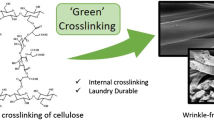Abstract
Importance of multifunctional finishing of textiles is increasing day by day due to greater consumer demand. Cross-linker is one of the commonly used finishes agent to impart functionality in textiles. In this research work the performance of the formaldehyde free carboxylic acid based eco-friendly cross-linkers; citric acid (CA) and maleic acid (MA) was enhanced by incorporating three different types of metal oxides nanoparticle (ZnO, MgO and CaO). Two different fixation methods of pad-dry-cure with and without UV irradiation were used. ZnO along with CA and MA was found to be most effective in increasing crease recovery performance of the cotton fabric followed by MgO while CaO was found to be ineffective. Fabric tear strength was also improved by the incorporation of these nanoparticles. Additionally, incorporation of these nanoparticles exhibited improvement in the fabric handle and antimicrobial properties.
Similar content being viewed by others
References
A. Roy, S. Samiran, M. Bhattacharya, and J. Bhattacharya, J. Biomed Nanotechnol, 9, 1570 (2013).
International Agency for Research on Cancer, Monographs on the Evaluation of Carcinogenic Risks to Humans, 88, 280 (2006).
P. Bajaj, J. Appl. Polym. Sci., 83, 631 (2002).
W. D. Schindler and P. J. Hauser, “Chemical Finishing of Textiles”, 1st ed., pp.29–36, Wood Head Publishing Limited, Cambridge, 2004.
M. Mohsin, N. Sarwar, S. Ahmad, A. Rasheed, F. Ahmad, A. Afzal, and S. Zafar, J. Clean. Prod, 112, 3525 (2016).
M. H. Abo-Shosha, Z. H. El-Hilw, A. Amr, and A. M. Rabie, J. Ind. Text., 39, 149 (2009).
Y. Chen, L. Yan, R. Wang, H. Fan, and Q. Zhang, Fiber. Polym., 11, 689 (2010).
E. S. Ates and H. E. Unalan, Thin Solid Films, 520, 4658 (2012).
A. K. Yetisen, H. Qu, A. Manbachi, H. Butt, M. R. Dokmeci, J. P. Hinestroza, M. Skorobogatiy, A. Khademhosseini, and S. H. Yun, ACS Nemo, 10, 3042 (2016).
M. Ashraf, P. Champagne, A. Perwuelz, C. Campagne, and A. Leriche, J. Ind. Text., AA, 44, 884 (2015).
R. Rajendra, C. Balakumar, H. Ahammed, S. Jayakumar, K. Vaideki, and E. Rajesh, Int. J. Eng. Sci. Technol., 2, 202 (2010).
J. A. Rodriguez, “Synthesis, Properties and Applications of Oxide NPs”, 1st ed., pp.491–583, John Wiles & Sons, Inc. Publication, 2007.
S. Kathirvelu, L. D'souza, and B. Dhurai, Indian J. Fibre Text., 34, 267 (2009).
T. Tsuzuki and X. Wang, Res. J. Text. Apparel, 14, 9 (2010).
Y. H. Lu, H. Lin, Y. Y. Chen, C. Wang, and Y. R. Hua, Fiber. Polym., 8, 1 (2007).
J. Sawai, H. Kojima, H. Igarashi, A. Hashimoto, S. Shoji, T. Sa-Waki, A. Hakoda, E. Kawada, T. Kokugan, and M. Shimizu, World J. Microbiol. Biotechnol, 16, 187 (2000).
Y. L. Lam, C. W. Kan, and C. W. M. Yuen, Fiber. Polym., 11, 551 (2010).
M. Hamadanian, A. Akbari, and V. Jabbari, Fiber. Polym., 12, 880 (2011).
G. Cheng, J. Dye Finish, 25, 14 (1999).
C. C. Wang and C. C. Chen, J. Appl. Polym. Sci., 97, 2450 (2005).
M. Ashraf, F. Irshad, J. Umar, A. Farooq, and M. A. Ashraf, RSC Adv., 6, 81069 (2016).
B. J. Trask-Morrell and B. A. Andrews, J. Appl. Polym. Sci., 42, 511 (1991).
C. Q. Yang and X. Wang, J. Appl. Polym. Sci. A., 35, 557 (1997).
Z. Wang, Y. Liu, and Z. Zhang, “Handbook of Nanophase and Nanostructured Materials”, p.997, Kluwer Academic Plenum., New York, 2002.
A. L. Linsebigler, G. Lu, and J. T. Yates, Chem. Rev., 95, 735 (1995).
J. Peiffer, K. O. Kim, and M. Takatera, Text. Res. J., 87, 424 (2017).
J. Sawai, J. Microbiol Methods., 54, 177 (2003).
S. H. Hsieh, Z. K. Huang, Z. Z. Huang, and Z. S. Tseng, J. Appl. Polym. Sci., 94, 1999 (2004).
D. Astruc, J. C. Blais, M. C. Daniel, V. Martinez, S. Nlate, and J. Ruiz, Macromol Symp., 196, 1 (2003).
Acknowledgments
This work was supported by the Higher Education Commission of Pakistan [NRPU Grant No. 6074].
Author information
Authors and Affiliations
Corresponding author
Rights and permissions
About this article
Cite this article
Sarwar, N., Ashraf, M., Mohsin, M. et al. Multifunctional Formaldehyde Free Finishing of Cotton by Using Metal Oxide Nanoparticles and Ecofriendly Cross-Linkers. Fibers Polym 20, 2326–2333 (2019). https://doi.org/10.1007/s12221-019-9170-y
Received:
Revised:
Accepted:
Published:
Issue Date:
DOI: https://doi.org/10.1007/s12221-019-9170-y




